Comparative Study on the Effects of Five Nano-Metallic Oxide Particles on the Long-Term Mechanical Property and Durability of Cement Mortar
Abstract
:1. Introduction
2. Materials and Methods
2.1. Experimental Materials
2.2. Sample Preparation of Cement Mortar with Nano-Metallic Oxide Particles
2.3. Test Methods
2.3.1. Flexural Strength Test
2.3.2. Compressive Strength Test
2.3.3. Porosity Test
2.3.4. Drying Shrinkage Test
2.3.5. Permeability Test
2.3.6. SEM Experiments
3. Results and Discussion
3.1. Compressive Strength
3.2. Flexural Strength
3.3. Porosity
3.4. Drying Shrinkage
3.5. Permeability
3.6. Microstructure Analysis
4. Conclusions
Author Contributions
Funding
Institutional Review Board Statement
Informed Consent Statement
Data Availability Statement
Acknowledgments
Conflicts of Interest
References
- Xu, L.; Wang, J.J.; Li, K.F.; Li, M.L.; Lin, S.Y.; Hao, T.Y.; Wang, T.Y.; Guo, Y.P.; Ling, Z. Investigations on the rehydration of recycled blended SCMs cement. Cem. Concr. Res. 2023, 163, 107036. [Google Scholar] [CrossRef]
- Dong, S.K.; Zhuo, Q.; Chen, L.L.; Wu, F.F.; Xie, L.L. Reuse of pretreated red mud and phosphogypsum as supplementary cementitious material. Sustainability 2023, 15, 2856. [Google Scholar] [CrossRef]
- Alany, A.A.; Lesovik, R.; Lesovik, V.; Fedyuk, R.; Klyuyev, S.; Arman, M.; Ali, M.; de Azevedo, A.R.G.; Vatin, N.I. Demolition waste potential for completely cement-free binders. Materials 2022, 15, 6018. [Google Scholar] [CrossRef]
- Kolesnikova, O.; Vasilyeva, N. Optimization of raw mix using technogenic waste to produce cement clinker. MIAB. Mining Inf. Anal. Bull. 2022, 60, 103–115. [Google Scholar] [CrossRef]
- Wu, Q.; Miao, W.S.; Zhang, Y.D.; Gao, H.J.; Hui, D. Mechanical properties of nanomaterials: A review. Nanotechnol. Rev. 2020, 9, 259–273. [Google Scholar] [CrossRef]
- Wang, X.Q.; Zhang, J.J.; Ta, W.R.; Xia, X.D.; Weng, G.J. Surface and interface effects on the bending behavior of nonlinear multilayered magnetoelectric nanostructures. Compos. Struct. 2021, 275, 114485. [Google Scholar]
- Xian, Y.; Feng, T.; Li, H.; Xing, Z.; Wang, G.; Cheng, H. The influence of nano-CaCO3 on the mechanical and dynamic thermo-mechanical properties of core–shell structured wood plastic composites. Forests 2023, 14, 257. [Google Scholar] [CrossRef]
- Cui, K.; Chang, J. Hydration, reinforcing mechanism, and macro performance of multi-layer graphene-modified cement composites. J. Build. Eng. 2022, 57, 104880. [Google Scholar] [CrossRef]
- Cui, K.; Liang, K.K.; Chang, J.; Lau, D. Investigation of the macro performance, mechanism, and durability of multiscale steel fiber reinforced low-carbon ecological UHPC. Constr. Build. Mater. 2022, 327, 126921. [Google Scholar] [CrossRef]
- Lu, D.; Ma, L.P.; Zhong, J.; Tong, J.; Liu, Z.B.; Ren, W.C.; Cheng, H.M. Growing nanocrystalline graphene on aggregates for conductive and strong smart cement composites. ACS Nano 2023. [Google Scholar] [CrossRef]
- Zhou, H.; Liu, J.; Yang, Y.; Liu, R. Experimental research on the workability and mechanical properties of grouting materials with nano-oxides. Materials 2023, 16, 329. [Google Scholar] [CrossRef] [PubMed]
- Adamu, M.; Çolak, A.B.; Ibrahim, Y.E.; Haruna, S.I.; Hamza, M.F. Prediction of mechanical properties of rubberized concrete incorporating fly ash and nano silica by artificial neural network technique. Axioms 2023, 12, 81. [Google Scholar] [CrossRef]
- Younus, S.J.; Mosaberpanah, M.A.; Alzeebaree, R. The performance of alkali-activated self-compacting concrete with and without nano-Alumina. Sustainability 2023, 15, 2811. [Google Scholar] [CrossRef]
- Choobbasti, A.J.; Valizadeh, M. The effect of nano-CuO on mechanical, microstructural, and self-healing properties of clayey sandy soils. Arab. J. Geosci. 2022, 15, 1346. [Google Scholar] [CrossRef]
- Madandoust, R.; Mohseni, E.; Mousavi, S.Y.; Namnevis, M. An experimental investigation on the durability of self-compacting mortar containing nano-SiO2, nano-Fe2O3, and nano-CuO. Constr. Build. Mater. 2015, 86, 44–50. [Google Scholar] [CrossRef]
- Rawdhan, R.R.; Jelawy, A.H. A comparative study of (Al2O3/CuO/Fe3O4) nanoparticles on the cementition brick properties. IOP Conf. Ser. Mater. Sci. Eng. 2020, 928, 022108. [Google Scholar] [CrossRef]
- Nazari, A.H.; Riahi, S. Effects of CuO nanoparticles on microstructure, physical, mechanical and thermal properties of self-compacting cementitious composites. J. Mater. Sci. Technol. 2011, 27, 81–92. [Google Scholar] [CrossRef]
- Han, B.G.; Ding, S.Q.; Wang, J.L.; Ou, J.P. Nano-Engineered Cementitious Composites: Principles and Practices; Springer: Berlin/Heidelberg, Germany, 2019. [Google Scholar]
- Agarkar, S.V.; Joshi, M.M. Study of effect of Al2O3 nanoparticles on the compressive strength and workability of blended concrete. Int. J. Curr. Res. 2012, 4, 382–384. [Google Scholar]
- Zhang, A.; Yang, W.C.; Ge, Y.; Du, Y.B.; Liu, P.H. Effects of nano-SiO2 and nano-Al2O3 on mechanical and durability properties of cement-based materials: A comparative study. J. Build. Eng. 2021, 34, 101936. [Google Scholar] [CrossRef]
- Feng, H.; Shen, S.H.; Pang, Y.Y.; Gao, D.Y.; Wang, Z.Y.; Sheikh, M.N. Mechanical properties of fiber and nano-Al2O3 reinforced magnesium phosphate cement composite. Constr. Build. Mater. 2021, 270, 121861. [Google Scholar] [CrossRef]
- Rashad, A.M. A synopsis about the effect of nano-Al2O3, nano-Fe2O3, nano-Fe3O4 and nano-clay on some properties of cementitious materials–A short guide for Civil Engineer. Mater. Des. 2013, 52, 143–157. [Google Scholar] [CrossRef]
- Wang, W.; Zhou, H.; Li, J.; Tao, F.F.; Li, C.H.; Qian, B.; Jiang, P. Influence of Carbonization Process on the Mechanical Properties of Nano-MgO Modified Cement Soil. Sustainability 2021, 13, 3558. [Google Scholar] [CrossRef]
- Yao, K.; Wang, W.; Li, N.; Zhang, C.; Wang, L.X. Investigation on strength and microstructure characteristics of nano-MgO admixed with cemented soft soil. Constr. Build. Mater. 2019, 206, 160–168. [Google Scholar] [CrossRef]
- Abdel-Gawwad, H.A.; Metwally, K.A.; Tawfik, T.A.; Mohammed, M.S.; Hassan, H.S.; Heikal, M.; El-Kattan, I.K. Evaluating the performance of high volume fly ash-blended-cement mortar individually containing nano-and ultrafine micro-magnesia. J. Build. Eng. 2021, 36, 102129. [Google Scholar] [CrossRef]
- Hou, P.K.; Cai, Y.M.; Cheng, X.; Zhang, X.Z.; Zhou, Z.H.; Ye, Z.M.; Zhang, L.N.; Li, W.G.; Shah, S.P. Effects of the hydration reactivity of ultrafine magnesium oxide on cement-based materials. Mag. Concr. Res. 2017, 69, 1135–1145. [Google Scholar] [CrossRef]
- Song, S.Q.; Jiang, L.H.; Jiang, S.B.; Yan, X.C.; Xu, N. The mechanical properties and electrochemical behavior of cement paste containing nano-MgO at different curing temperature. Constr. Build. Mater. 2018, 164, 663–671. [Google Scholar] [CrossRef]
- Mo, L.; Deng, M.; Wang, A. Effects of MgO-based expansive additive on compensating the shrinkage of cement paste under non-wet curing conditions. Cem. Concr. Compos. 2012, 34, 377–383. [Google Scholar] [CrossRef]
- Senff, L.; Tobaldi, D.M.; Lemes-Rachadel, P.; Labrincha, J.A.; Hotza, D. The influence of TiO2 and ZnO powder mixtures on photocatalytic activity and rheological behavior of cement pastes. Constr. Build. Mater. 2014, 65, 191–200. [Google Scholar] [CrossRef]
- Mohseni, E.; Naseri, F.; Amjadi, R.; Khotbehsara, M.M.; Ranjbar, M.M. Microstructure and durability properties of cement mortars containing nano-TiO2 and rice husk ash. Constr. Build. Mater. 2016, 114, 656–664. [Google Scholar] [CrossRef]
- Nazari, A.; Riahi, S. The effects of ZnO nanoparticles on strength assessments and water permeability of concrete in different curing media. Mater. Res. 2011, 14, 178–188. [Google Scholar] [CrossRef] [Green Version]
- Shafeek, A.M.; Khedr, M.H.; Dek, S.I.; Shehata, N. Influences of calcium sulfate bearing material and zinc oxide nanoparticle on hydration properties of white cement clinke. J. Mater. Res. Technol. 2021, 11, 2003–2014. [Google Scholar] [CrossRef]
- Voicu, G.; Tiuca, G.A.; Badanoiu, A.I.; Holban, A.M. Nano and mesoscopic SiO2 and ZnO powders to modulate hydration, hardening and antibacterial properties of portland cements. J. Build. Eng. 2022, 57, 104862. [Google Scholar] [CrossRef]
- Umarajyadav, M.V. Study of mechanical properties of concrete with nano zirconia. Int. Res. J. Eng. Technol. 2017, 4, 90–94. [Google Scholar]
- Wang, J.L.; Ding, S.Q.; Han, B.G.; Ni, Y.Q.; Ou, J.P. Self-healing properties of reactive powder concrete with nanofillers. Smart Mater. Struct. 2018, 27, 115033. [Google Scholar] [CrossRef]
- Wang, D.N.; Zheng, Q.F.; Ou, Y.J.; Yu, X.; Han, B.G. Influences of curing period on mechanical properties of reactive powder concrete incorporating nanoparticles. Mater. Res. Express 2018, 6, 025023. [Google Scholar] [CrossRef]
- Jaishankar, P.; Mohan, K.S.R. Experimental investigation on nano particles in high performance concrete. Int. J. Chem. Res. 2015, 8, 1666–1670. [Google Scholar]
- Wang, D.; Zhang, W.; Han, B. New generation of cement-based composites for civil engineering. In New Materials in Civil Engineering; Butterworth-Heinemann: Amsterdam, The Netherlands, 2020; pp. 777–795. [Google Scholar]
- Wang, D.N.; Zhang, W.; Ruan, Y.F.; Han, B.G. Enhancements and mechanisms of nano-particles on wear resistance and chloride penetration resistance of reactive powder concrete. Constr. Build. Mater. 2018, 189, 487–497. [Google Scholar] [CrossRef]
- GB/T 17671-2021; The Method of Cement Mortar Strength Test Method (ISO Method). China Standard Press: Beijing, China, 2021.
- JC/T 603-2004; Standard Test Method for Drying Shrinkage of Mortar. China Building Materials Press: Beijing, China, 2004.
- Liu, J.T.; Li, Q.H.; Xu, S.L. Influence of nanoparticles on fluidity and mechanical properties of cement mortar. Constr. Build. Mater. 2015, 101, 892–901. [Google Scholar] [CrossRef]
- Barbhuiya, S.; Mukherjee, S.; Nikraz, H. Effects of nano-Al2O3 on early-age microstructural properties of cement paste. Constr. Build. Mater. 2014, 52, 189–193. [Google Scholar] [CrossRef]
- Meral, O.; Remzi, S. Pore structure analysis of hardened cement mortars containing silica fume and different nano-powders. Constr. Build. Mater. 2014, 53, 658–664. [Google Scholar]
- Singh, G.; Saini, B. Nanomaterial in cement industry: A brief review. Innov. Infrastruct. Solut. 2022, 7, 45. [Google Scholar] [CrossRef]
- Patil, H.; Dwivedi, A. Impact of nano ZnO particles on the characteristics of the cement mortar. Innov. Infrastruct. Solut. 2021, 6, 222. [Google Scholar] [CrossRef]
- Li, X.Y.; Li, J.; Lu, Z.Y.; Chen, J.K. Properties and hydration mechanism of cement pastes in presence of nano-ZnO. Constr. Build. Mater. 2021, 289, 123080. [Google Scholar] [CrossRef]
- Tian, C.J.; Wang, Y.Z.; Qiu, K.; Yang, Q.L. Effects of submicron-MgO and nano-MgO on the expansion and microscopic properties of high-performance concrete. J. Cent. South Univ. 2022, 29, 3186–3200. [Google Scholar] [CrossRef]
- Chen, Y.H.; Liu, J.S.; Gao, F.; Feng, B.W.; Wei, J.; Zhang, Y.D.; Wang, L. Effect of nano-MgO on basic properties and microstructures of cement-based materials. Emerg. Mater. Res. 2022, 11, 376–387. [Google Scholar] [CrossRef]
- Al-Jadiri, R.S.F.; Rahma, N.M.; Eweed, K.M. Producing a new type of cement by adding Zirconium Oxide. IOP Conf. Ser. Mater. Sci. Eng. 2018, 454, 012149. [Google Scholar] [CrossRef]
- Han, B.G.; Wang, Z.; Zeng, S.Z.; Zhou, D.C.; Yu, X.; Cui, X. Properties and modification mechanisms of nano-zirconia filled reactive powder concrete. Constr. Build. Mater. 2017, 141, 426–434. [Google Scholar] [CrossRef] [Green Version]

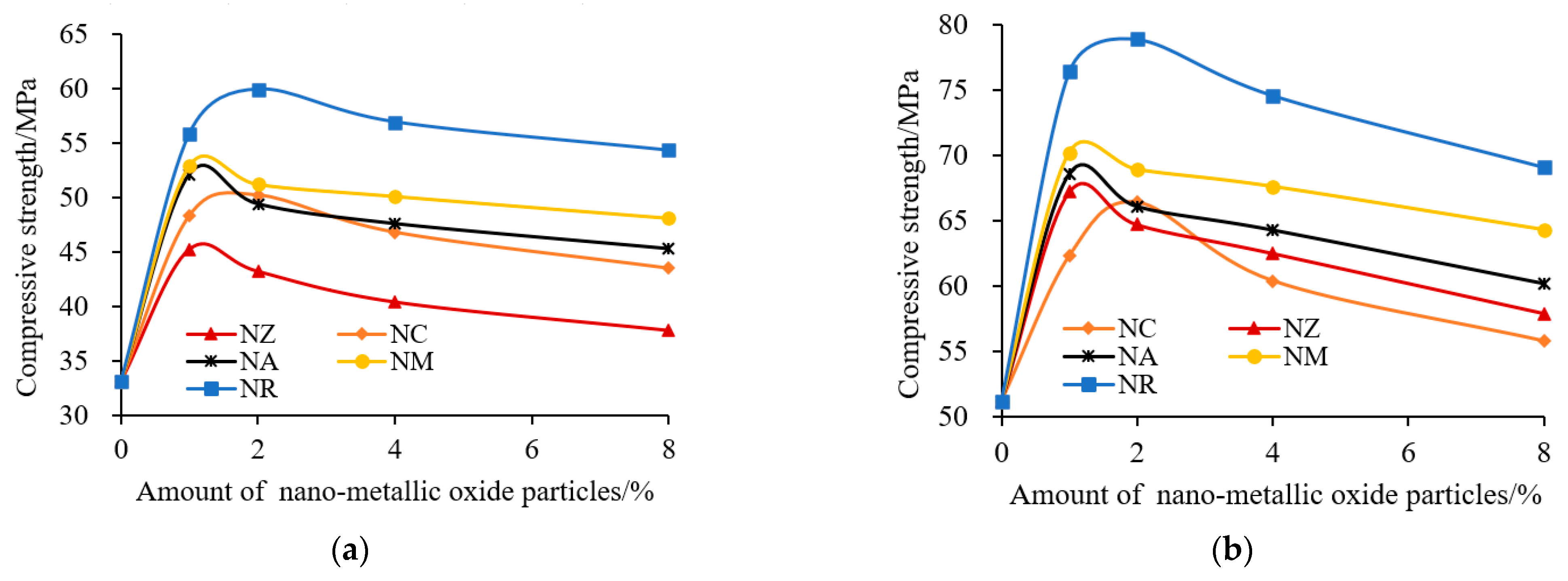


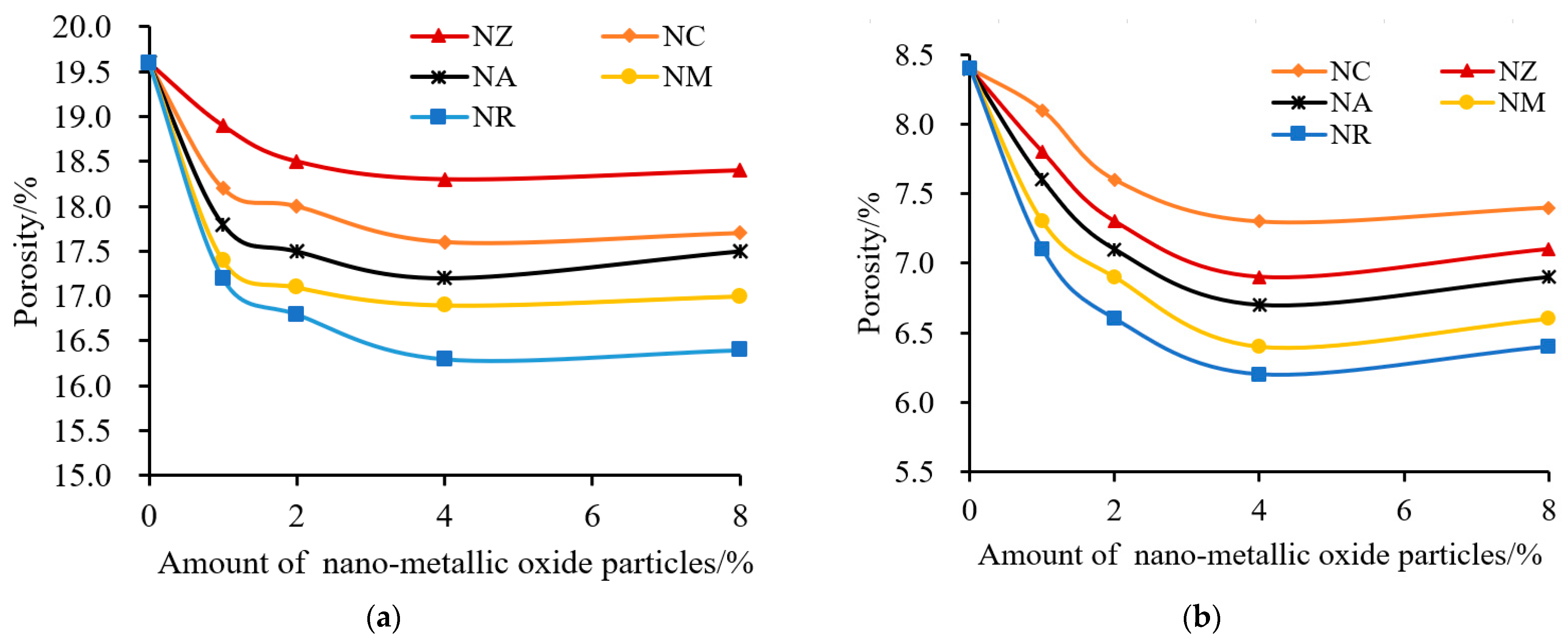




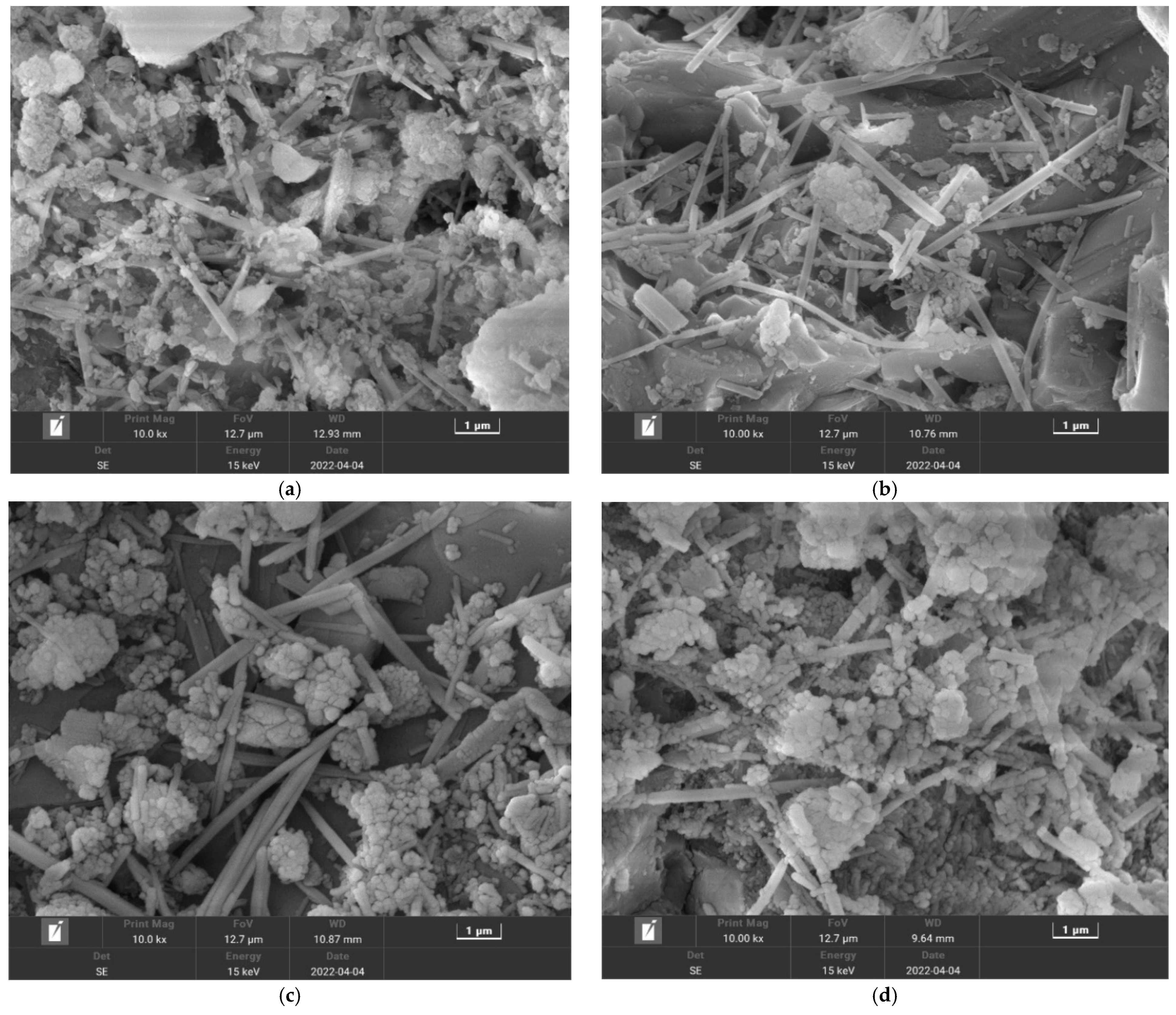
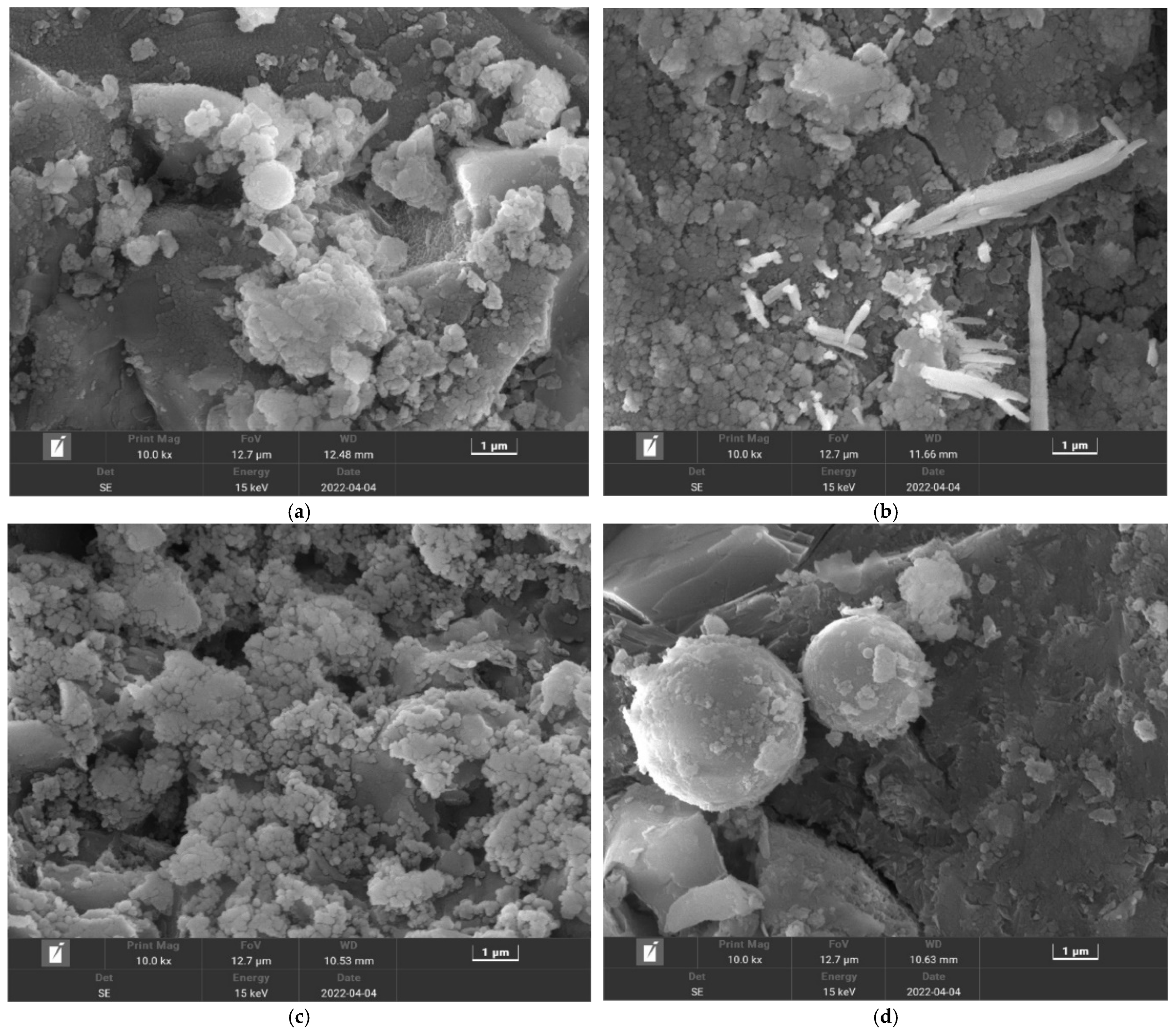
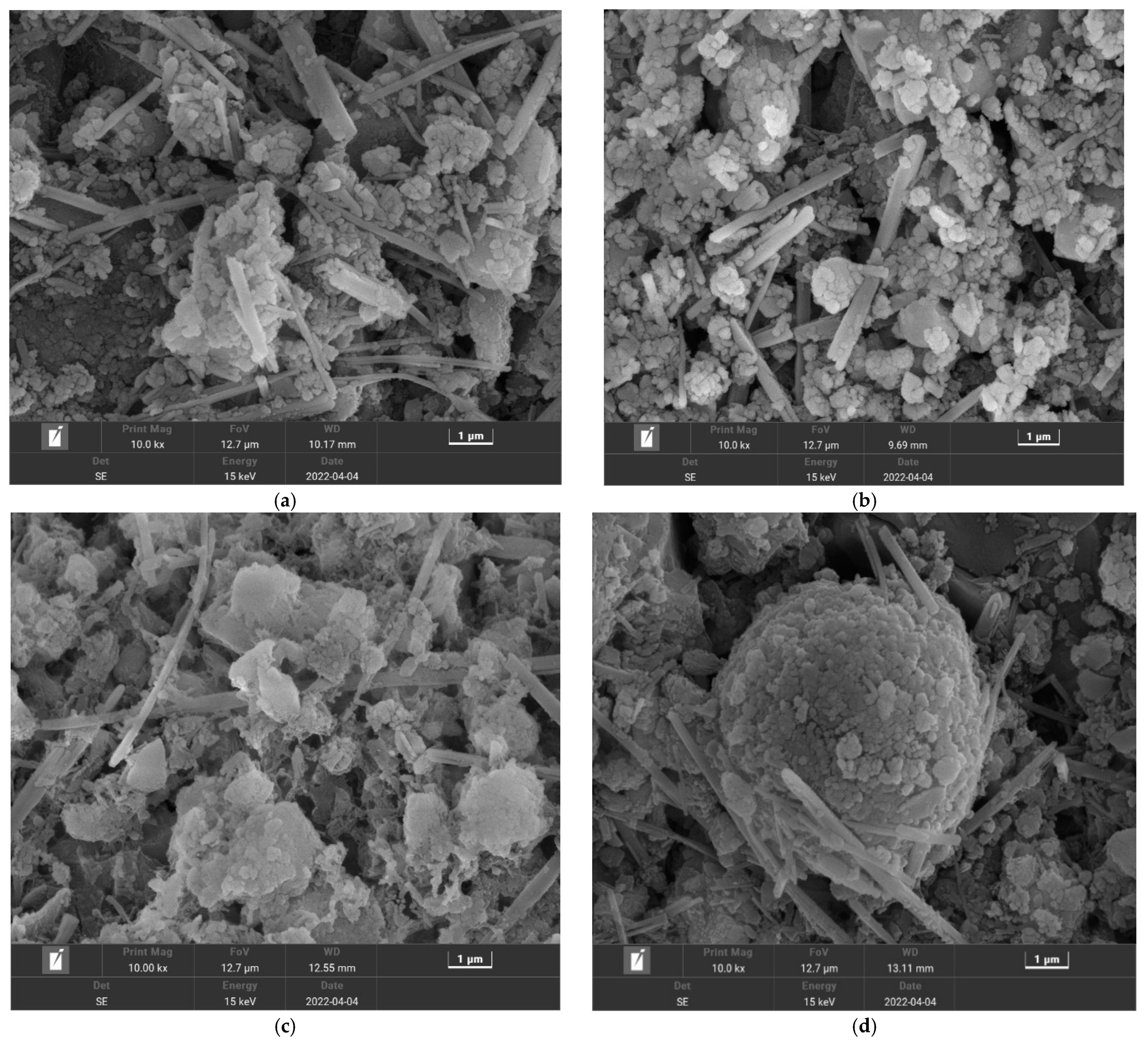
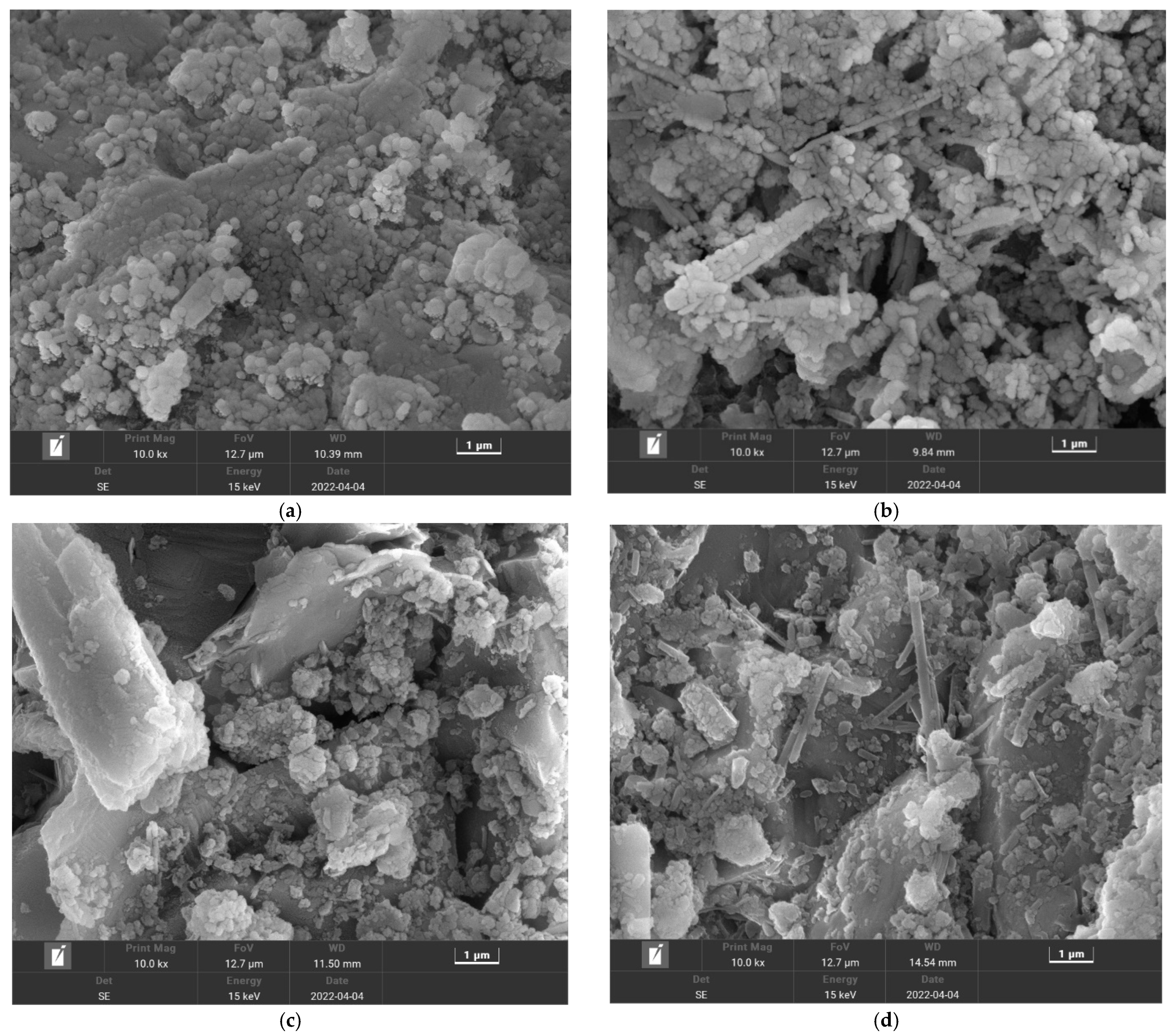
| Cement Type | Standard Consistency | Density | Soundness of Cement |
|---|---|---|---|
| P·O42.5R | 26.8% | 3.05 g/cm3 | Qualified |
| Element | SiO2 | Al2O3 | Fe2O3 | CaO | MgO | SO3 | Na2O | K2O | ZrO2 | CuO | ZnO |
|---|---|---|---|---|---|---|---|---|---|---|---|
| Cement/wt% | 27.5 | 6.59 | 4.89 | 54.87 | 2.69 | 2.66 | 0.46 | 0.34 | - | - | - |
| NM/wt% | - | - | - | - | 99.9 | - | - | - | - | - | - |
| NA/wt.% | - | 99.9 | - | - | - | - | - | - | - | - | - |
| NR/wt.% | - | - | - | - | - | - | - | - | 99.9 | - | - |
| NC/wt.% | - | - | - | - | - | - | - | - | - | 99.9 | - |
| NZ/wt.% | - | - | - | - | - | - | - | - | - | - | 99.9 |
| Nanomaterials | NM | NA | NR | NC | NZ |
|---|---|---|---|---|---|
| Color | White | White | White | Black | White |
| Density(g/cm3) | 3.58 | 3.90 | 6.0 | 6.49 | 5.60 |
| Purity (%) | 99.9 | 99.9 | 99.9 | 99.9 | 99.9 |
| Fineness (nm) | 30 | 30 | 30 | 30 | 30 |
| No. | Cement | NC | NR | NM | NA | NZ | Standard Sand | Water |
|---|---|---|---|---|---|---|---|---|
| NC-0 | 550.0 | 0 | 1100 | 220 | ||||
| NC-1 | 544.5 | 5.5 | 1100 | 220 | ||||
| NC-2 | 539.0 | 11 | 1100 | 220 | ||||
| NC-4 | 528.0 | 22 | 1100 | 220 | ||||
| NC-8 | 506.0 | 44 | 1100 | 220 | ||||
| NZ-1 | 544.5 | 5.5 | 1100 | 220 | ||||
| NZ-2 | 539.0 | 11 | 1100 | 220 | ||||
| NZ-4 | 528.0 | 22 | 1100 | 220 | ||||
| NZ-8 | 506.0 | 44 | 1100 | 220 | ||||
| NM-1 | 544.5 | 5.5 | 1100 | 220 | ||||
| NM-2 | 539.0 | 11 | 1100 | 220 | ||||
| NM-4 | 528.0 | 22 | 1100 | 220 | ||||
| NM-8 | 506.0 | 44 | 1100 | 220 | ||||
| NA-1 | 544.5 | 5.5 | 1100 | 220 | ||||
| NA-2 | 539.0 | 11 | 1100 | 220 | ||||
| NA-4 | 528.0 | 22 | 1100 | 220 | ||||
| NA-8 | 506.0 | 44 | 1100 | 220 | ||||
| NN-1 | 544.5 | 5.5 | 1100 | 220 | ||||
| NN-2 | 539.0 | 11 | 1100 | 220 | ||||
| NN-4 | 528.0 | 22 | 1100 | 220 | ||||
| NN-8 | 506.0 | 44 | 1100 | 220 |
Disclaimer/Publisher’s Note: The statements, opinions and data contained in all publications are solely those of the individual author(s) and contributor(s) and not of MDPI and/or the editor(s). MDPI and/or the editor(s) disclaim responsibility for any injury to people or property resulting from any ideas, methods, instructions or products referred to in the content. |
© 2023 by the authors. Licensee MDPI, Basel, Switzerland. This article is an open access article distributed under the terms and conditions of the Creative Commons Attribution (CC BY) license (https://creativecommons.org/licenses/by/4.0/).
Share and Cite
Dong, S.; Yu, S.; Chen, L.; Zhuo, Q.; Wu, F.; Xie, L.; Liu, L. Comparative Study on the Effects of Five Nano-Metallic Oxide Particles on the Long-Term Mechanical Property and Durability of Cement Mortar. Buildings 2023, 13, 619. https://doi.org/10.3390/buildings13030619
Dong S, Yu S, Chen L, Zhuo Q, Wu F, Xie L, Liu L. Comparative Study on the Effects of Five Nano-Metallic Oxide Particles on the Long-Term Mechanical Property and Durability of Cement Mortar. Buildings. 2023; 13(3):619. https://doi.org/10.3390/buildings13030619
Chicago/Turabian StyleDong, Shuangkuai, Songhan Yu, Liangliang Chen, Qi Zhuo, Fufei Wu, Lilan Xie, and Liuyan Liu. 2023. "Comparative Study on the Effects of Five Nano-Metallic Oxide Particles on the Long-Term Mechanical Property and Durability of Cement Mortar" Buildings 13, no. 3: 619. https://doi.org/10.3390/buildings13030619






